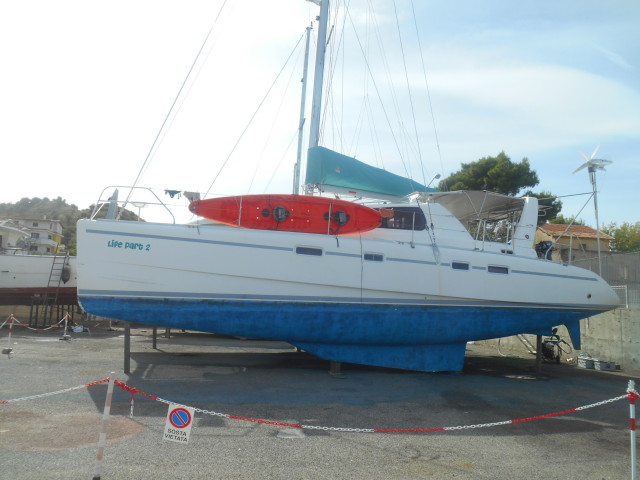Hauled Out and Batteries In – 4 Wheels on My Wagon!
Current Position: 39 30.28 N 016 56.44 E Click to view map.
Distance sailed since last post: 58 nautical miles. View the map of our voyage track here
Sorry about the long delay in getting this post up! Yes, we are actually now in Edmonton, Canada, and have been for almost 3 weeks. But you know how it is.
Actually, how it is, is that each time we go back to Canada for the winter we seem to get sick. Usually a nasty cough with a fever that just seems to hang around. And this time was no different. But I think and hope that we are on the mend again and can start to enjoy the charms of Edmonton. You know: Minus 20 deg outside. Plus 20 deg inside with air so dry it turns your nose into sandpaper. A monotonous flat landscape with nary a feature of interest in sight. And lots of large malls in which to go shopping. Well, what else do you do here?
But I digress. I was going to tell you about our hauling out saga – and our new batteries!
From Gallipoli we sailed across the Gulf of Taranta (the town after which a certain spider was named) to arrive in Crotone just before a big storm that was forecast. The expectation was for 5 meter waves from the SE, so we figured we had better duck into the marina for a couple of days. Even then it was still pretty lumpy.
Once it had settled we nipped around to the other side to get hauled out by Elio in Porto Vecchio. We had a couple of day’s wait, but that allowed us to charge up and install my brand spanking new Lithium batteries! It is amazing how much smaller and lighter these are. And by virtue of the fact that they can be discharged much lower than lead acid, we need only a 300Ahr battery to replace our 600Ahr AGM’s. How nice to have some power available again!
Then came the haul out.
Now, Elio has a crane, not a travel lift. The crane has spreader bars, so the idea is simple, you put the hook and spreader bars behind the mast and run two straps under the boat, one forward of the keels and one aft. Then you lift.
Except that it turns out that a Leopard 42 has the center of gravity only about 1 m abaft the mast. To lift the boat nice and steadily the hook needs to be directly above the center of gravity. But the mast is in the way, preventing the spreaders from going far enough forward to bring the hook over the COG.
The net result? As we lift the boat out of the water, the bow drops down. Clearly this is not the case for other types of cats, as we could see our friends’ Far Out sitting comfortably on the hard, waiting for us to join her!
After about 5 hours of trying different experiments it became clear that this was not going to work. There was no way we would be hauling out in Crotone.
Now what?
After a day thinking we might have to sail the 250 miles to Mesolonghi in Greece, we found a tiny harbour just 32 nm up the coast who had a travel lift and so could pull us out.
So that is where Life Part 2 ended up: Cariati is a delightful little town. Very quiet. The harbour is small, and there are just two cats (including us) and a few fishing boats on the hard. If you zoom in on the map/satellite image above you can see the tiny hard where we are parked. On that image there are two yachts. Now there are still only two yachts, but one of them is now Life Part 2.
There is also quite a nice beach, so we were swimming daily until the day we departed.
Touring South Italy
We had booked to fly out of Rome, and decided to rent a one-way car so that we could do a bit of touring on the way. That was definitely the right thing to do.
We had some lovely walks in the mountains and stayed in delightful ‘Agro-tourism’ B&B’s
And we got to visit Pompeii, which is worth a post of its own (though we probably won’t get around to it, but I will try to talk Ceu into putting us some pictures!)
But the driving in Italy is crazy. Narrow streets which the drivers then subdivide into more lanes than the original engineer had intended. Still, we survived, had a brief visit in England with the parents, and then made it to Edmonton.
So now you are up to date!







Hi,
I really enjoy your blog. We hope to follow in your path in a few years. We have a Leopard 43 and plan on having to lift it with a crane this spring to load onto a ship. Can you offer any more insight into what you tried that didn’t work and any ideas that you might have tried based on your experience? Unfortunately there’s no alternative except for a crane to load our boat onto the ship.
Thank you!
Thanks. We often wonder if there is anyone out there actually reading what we write!
The crane we were using had short slings and basically a square spreader arrangement. This means that the spreaders were held back by the mast, and so we couldn’t get the hook far enough forward to be above the center of gravity. Obviously this is not an issue for Lagoons or Fontaine Pajots, both of which were hauled out by Elio without any difficulty. It seems to me that there are two ways around this. The first is to have a U-shaped spreader system, rather like a travel lift, so that the spreader arms can go forward around each side of the mast. The other way would be to have much longer slings which is, I am told, how they do it in Malta. The reason I mention that is that I have emailed them, and they told me that they do most cats using a 100 ton crane with long slings. You might want to write to Andrew Wilson (awilson) at yachtyard-malta.com to see if he can give you any more advice on that. By having very long straps you may still get some tilt, but it should be much less dramatic than what we were getting.
When you do get it hauled, you may find it helpful to show them the photo from our site, as they can then see exactly where the straps in front and behind the keel will go. (Yours should be identical). Obviously what you will be aiming for is to have the crane’s hook end up mid-way between the front and back straps which, as you can see from the photo, is just behind the mast.
Hope that helps. Are you shipping your boat somewhere nice?
Glad to hear you made it safely back to Canada. Now with the family and grand children in Edmonton, does that mean you won’t be wintering in Kelowna or skiing? Let me know if and when you will be heading this way. Big White and Silver Star and supposed to open next Thursday, but at the moment there is no snow. As you know, it’s all back east!
I have put in my website Ceu so you can look up Partylite stuff for any Christmas shopping you may want to do. You can place the order online through my website and have delivered directly to yourself anywhere in Canada. There are usually some sales going on too. Go in and check it out.
Look forward to hearing from you.
Love, Marlene
Hi noel,
nice blog! stumbled across it as I am considering switching to lithium as well…
Did you have to change your charging setup? Or did your charger / alternator / pv- and wind-controller already support lithium?
Second, where did you order the batteries / how much did they roughly cost / how long did it take?
Thanks!
Dennis
HI Dennis
We only just made the switchover at Crotone, so have not had a chance to test it all out yet. I will write a fuller blog when it is all done.
After a heap of research it seems that the charging is actually straight forward – just make sure that you don’t ever charge above 3.65v per cell (apart from your initial charge to 4v) and you are fine, you can float it at this level indefinitely and keep your batteries at about 90% charge. If you have the option, pick the gel setting on your charger.
I ordered them from ev-power.eu and they came straight away. We couldn’t order them to Croatia as we could not get delivery to there. They don’t, however, give any advice or help, you have to figure it out yourself. There is an excellent (but very long) thread on Cruisers Forum on the topic.
It starts out very complicated but, in the end, is very simple.
And they should last for years.
Noel
Hi Noel,
Like your blog. I found it as I was looking a spinnaker for our boat at the time (S/V The Selkirk Grace). She sold just before I got a chance. So, temporarily boatless, I am working on our next adventure. Curiosity has me wondering about your research and choosing Lithium. Are you talking about LiFePo4, as these seem quite amazing.
When are you headed out again and where to next?
Chip
Sandpoint, Idaho
Hi Chip,
Yes, the LiFePO4. So far I am VERY impressed with them. They certainly charge quickly, which means they can use the inputs from alternators, solar and wind much more efficiently. Which means we stay more fully charged all the time. And they are so small and light!
Initially I was very confused about all the differing advice on how to charge, discharge and manage them. Finally I figured out that all these people are using them for electric cars or model airplanes and that, in both cases, they are wanting to a) charge and discharge over as large a range as possible, and b) charge and discharge them with high currents.
We do neither. We are not interested in charging them completely to 100%. 95% will do us fine, and is much safer for the batteries. Likewise on discharge. We don’t want to go down to 10%. 30% is fine, and much safer. Finally, we generally are running at less than 0.1C (ie. 30 amps on our 300 AHr battery) compared with their 1C or even 5C!
So, once you have figured that out, it all becomes much easier and less stressful. Just don’t charge them higher than 3.5v per cell (14 v for the battery), float them at 3.4v per cell (13.6v), and don’t over discharge them. Do that, and they will probably last longer than you own your boat.
I am still fine tuning my set up. Once I have done so, I will write a detailed set of instructions on how to put it all together so that it works, including various automated safety and fail-safe features, and you don’t have to stress over them.
So, if you are thinking of going that route, my vote is YES.
Noel